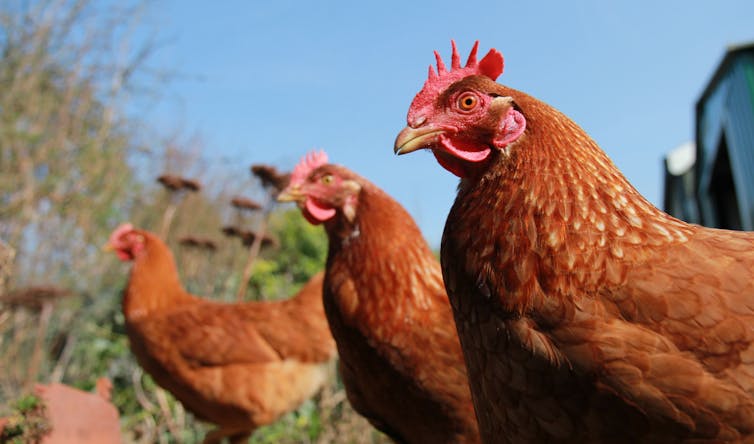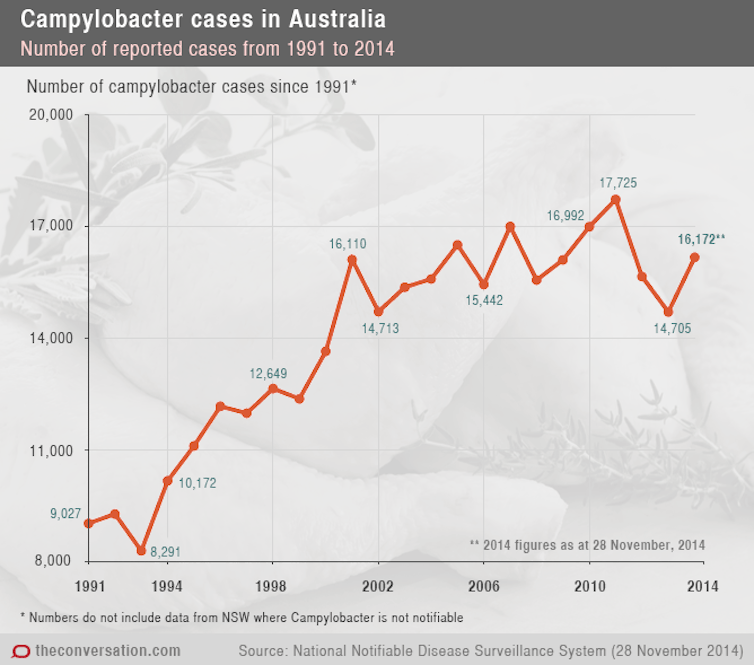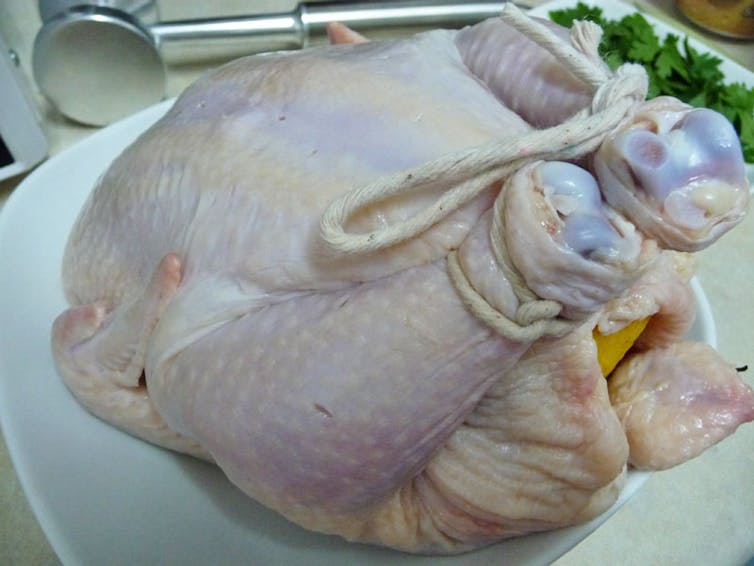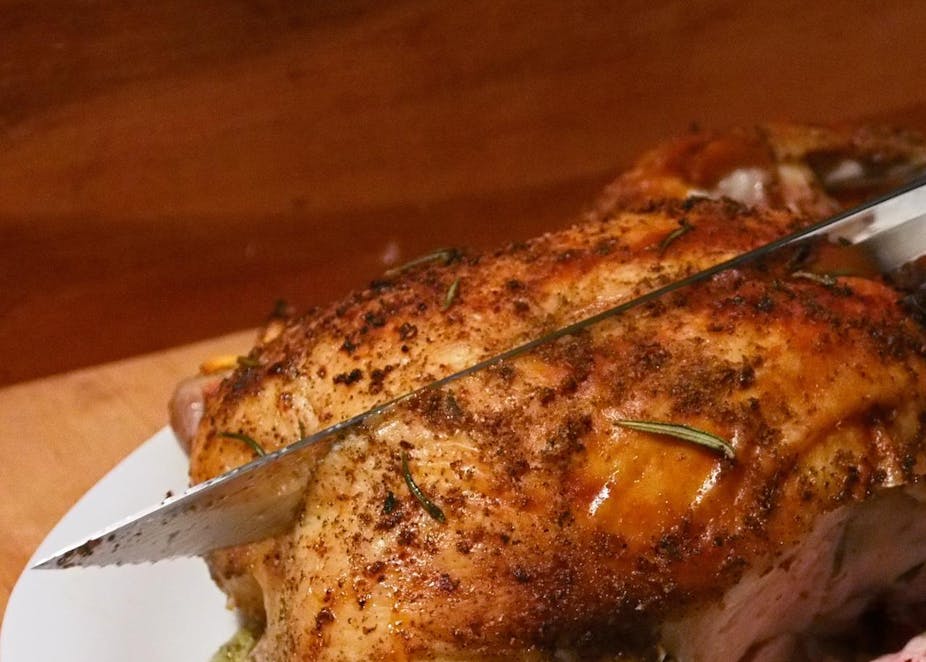Chicken meat is an extremely popular and affordable source of animal protein, and each Australian now consumes approximately 43 kilograms of it every year. But chicken is also uniquely prone to making people ill, due to contamination with bacteria.
Most people would know chicken meat can cause Salmonella infections, but there is a lesser known yet more common bacteria that also loves chicken meat and can make you ill.
Campylobacter actually causes very similar clinical illness to Salmonella, but is less likely to cause outbreaks (defined as two or more people infected after eating a common food or meal) so gets less publicity than the outbreak-prone Salmonella.
Making you ill
Campylobacter recently caused a stir in the United Kingdom, after a survey found eight out of ten portions of poultry meat sold in supermarkets there were contaminated. The situation in Australia is likely to be similar although limited recent data have been published.
Campylobacter is, in fact, one of the leading causes of gastroenteritis from food around the world. Infection with this bacteria results in diarrhoea, abdominal cramping, and fever lasting up to a week. And while it’s rarely fatal, it can also result in chronic illnesses, such as reactive arthritis, irritable bowel syndrome, and Guillain–Barré syndrome.

You can become ill from Campylobacter after eating contaminated foods, having close contact with infected animals or people, or by drinking contaminated water or unpasteurised milk. The link between contaminated chicken meat and Campylobacter infections in humans is not new, but it is possible to reduce the risk.
Consider the case of New Zealand. In the mid-2000s, that country had among the highest rates of Campylobacter infection in the world. Studies examining the causes of infection highlighted contaminated chicken meat as the main source.
In 2006, advocacy by New Zealand public health professionals led to improved controls, including interventions by the chicken meat industry and government, resulting in dramatic declines in infection. Since that time, New Zealand has conducted surveillance of molecular strains of Campylobacter to understand the sources of infections and monitor interventions in the food supply.
Australia has had consistently lower rates of Campylobacter infections than New Zealand, but higher incidence than countries such as the United States. State-based health departments in Australia have actually reported a steady increase in cases in recent decades, although there has been a decline in the last couple of years as shown by the figure below.

But these numbers don’t provide the whole picture. Many people who become infected don’t go to a doctor or get tested, meaning their illness is never reported. There are probably as many as 179,000 cases of foodborne Campylobacter infection in Australia annually.
A 2008 Australian study on the sources of such infection in 2001-2, found 29% were likely to be due to chicken meat, 2% due to offal, 3% due to contact with puppies and 2% due to chickens less than six months old. But the majority of the infection sources were unable to be identified.
Protecting against infection
Campylobacter is commonly found in the intestinal tracts of birds, but may not make them sick. Meat as well as the processing environment can become contaminated during the slaughter and processing of chickens, particularly when removing the feathers and intestines.
Recent declines in Campylobacter infection in Australia are encouraging and have occurred despite increasing consumption of chicken meat. Nevertheless, consumers need to be on their game when it comes to handling and cooking meat from chickens and other types of poultry.
There are steps you can take to minimise your risk of infection. First, when storing chicken meat in the fridge, ensure it doesn’t touch food that will be eaten without cooking. It’s also important not to cut chicken meat up on a board that’s used for ready-to-eat foods, such as salads.

Even the juices from chicken meat and packaging can be contaminated with Camplyobacter. Avoid washing poultry prior to cooking to not contaminate your kitchen sink and benches. Make sure juices can’t drip on other foods in the fridge. And thoroughly wash all chopping boards and utensils used for raw chicken meat, as well as your hands; hot soapy water is vital.
Finally, cook poultry meat to an internal temperature of 75° Celsius (using a thermometer) and don’t eat undercooked meat or liver.
One reason we don’t see many foodborne Campylobacter outbreaks is because the bacteria doesn’t grow well on food, having a narrow growth range of between 37°to 42°C. The bacteria is, in fact, quite fragile, and can be killed by drying, exposure to oxygen-rich environments, and highs and lows in temperature, such as that achieved by cooking or freezing.
But lowering rates of contamination of chickens with Campylobacter requires government, industry, retailers, and consumers to work together, which is what the UK is doing to resolve its poultry crisis. In 2012, the Australian government and industry developed primary production and processing standards. It may be some time before their effects can be assessed.
In the meantime, people cooking with raw chicken meat should be fastidious about food safety in the kitchen.

